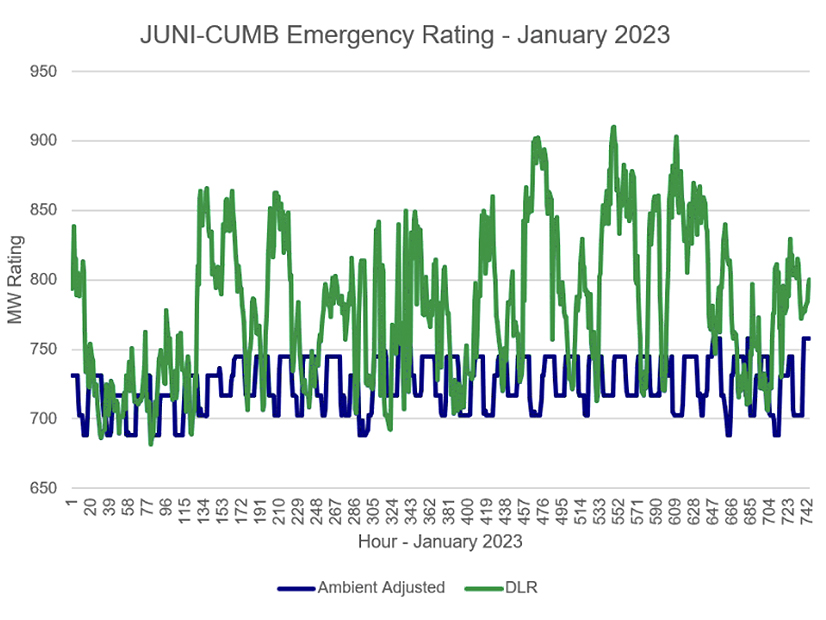
Grid-enhancing technologies (GETs) already have worked in some areas, and they are set to grow with new federal funding opportunities, experts said on a webinar Tuesday hosted by the Clean Energy States Alliance.
PPL had been looking into using dynamic line ratings (DLRs) since 2020, and it went live with several projects starting last October, including one that has expanded the capacity of its Juniata-Cumberland line in Pennsylvania by 18% under normal conditions and 10% under emergency conditions, said Joseph Lookup, director of asset management.
DLRs consider local conditions such as the ambient air temperature, wind speed, the temperature of the conductor and how much the line is sagging to determine how much power can reliably flow through a transmission line. The sensors used in the technology also can measure the health of the conductor.
Upgrading transmission lines is a costly and complex engineering process, but getting DLRs running was fairly easy, Lookup said. It involved installing sensors on the lines, which takes a couple of days, and building out the information technology system needed to bring the data produced back to PPL and PJM’s transmission operators, he said.
“Since we went live in October 2022, we are seeing an average increase … for the normal and the emergency readings,” Lookup said. “And by doing this, it really has hit home with the customers by saving them costs for congestion … that we were able to avoid by making a bigger pipe for the power to flow through.”
PPL’s proposal to use DLRs won out in the market efficiency window of PJM’s planning process as a cost-effective way of improving the grid. The projects were estimated to save consumers $23 million annually by the RTO, but so far, grid conditions have made it so the savings exceed that estimate, Lookup said.
The New York Energy Research and Development Authority (NYSERDA) has been looking into GETs in recent years to determine how much power it can push through its existing grid, said Senior Project Manager Mike Razanousky.
NYSERDA has been looking into DLRs as well, which can be accomplished using the sensors PPL has installed, but also with more remote approaches, such as using lidar to measure the conditions of a line, and installing weather stations. It also has looked into power flow controls such as phase angle regulators, which can change the flow of power to maximize the use of the existing grid, and storage as a transmission asset.
“When we started this work, we didn’t have FERC Order 881, which is now requiring all of us to go to [ambient-adjusted ratings (AARs)] by July of 2025,” Razanousky said.
AARs take into account only local air temperatures; Order 881 also opened a docket to study requiring DLRs around the country. (See FERC Orders End to Static Tx Line Ratings.) WATT Coalition Executive Director Julia Selker noted that the latter offers more efficient use of existing transmission because wind is a bigger factor in transmission lines’ ever-changing capacity than air temperature.
NYSERDA is working with Avangrid on the demonstration of a mobile unit that can measure its transmission system’s conditions, and Central Hudson Gas & Electric is installing a permanent system at a substation, Razanousky said.
Another option for helping increase efficiency on the grid is deploying storage as transmission assets; NYSERDA is working on a study that will look into the question, Razanousky added.
The Infrastructure Investment and Jobs Act included up to $14 billion over five years for states and utilities to try out all kinds of GETs, Selker said. The money can help bring the technologies from the pilot level to be used broadly across the entire country.
The grants are available for both states and the industry under various programs, and Selker said the Department of Energy should announce the first ones shortly.
“To put forward a grid-enhancing technologies proposal, you really have to partner with both a technology vendor and a utility to identify needs and impacts and what stage the utilities are at in adopting these technologies,” Selker said. “So, I really encourage you to do that groundwork; find out what’s feasible.”
The more recent Order 2023 on interconnection queues also requires consideration of GETs, she added. (See FERC Updates Interconnection Process with Order 2023.) While utilities will look at AARs under Order 881, Selker argued it makes sense for them to start considering the more efficient DLRs at the same time. Under Order 2023, utilities have full discretion on how to evaluate and implement the transmission technologies.
“It really looks like it’s down to the state oversight to make sure that the RTOs and the transmission owners are doing that meaningful evaluation of these technologies and fully incorporating them in the processes,” Selker said.

